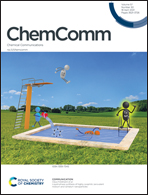Promiscuous dye binding by a light-up aptamer: application for label-free multi-wavelength biosensing†
Abstract
Light-up DNA aptamers are promising label-free signal-transducers for biosensing applications due to their high chemical stability and low synthetic cost. Herein, we demonstrate that a dapoxyl DNA aptamer DAP-10–42 can be converted into a sensor generating a fluorescence signal at different wavelengths in the range of 500–660 nm depending on the dye that is present. This results from the discovered promiscuity of DAP-10–42 in binding fluorogenic dyes including arylmethane dyes. We have designed a split DAP-10–42 aptasensor for the detection of a katG gene fragment from Mycobacterium tuberculosis with a point mutation causing isoniazid resistance. Efficient interrogation of the gene fragment after nucleic acid sequence-based amplification (NASBA) is achieved directly in a protein-containing NASBA sample. This report lays a foundation for the application of the DAP-10–42 aptamer as a versatile sensing platform.



 Please wait while we load your content...
Please wait while we load your content...